Economics
Unit 4 Section 1
>Economics
Section 1 Economics (GOVT.1, 14, 15)
Objective 1:
Three Basic Economic Questions—the student will apply social science skills to understand economic systems by identifying the basic economic questions encountered by all economic systems. (GOVT.14a)
Objective 2:
Government Involvement—the student will apply social science skills to understand economic systems by comparing the characteristics of traditional, free market, command, and mixed economies, as described by Adam Smith and Karl Marx. (GOVT.14b)
Objective 3:
Choice—the student will apply social science skills to understand economic systems by evaluating the impact of the government's role in the economy on individual economic freedoms. (GOVT.14c)
Objective 4:
Economic Freedom and Political Freedom—the student will demonstrate knowledge of economic systems by explaining the relationship between economic freedom and political freedom. (GOVT.14d)
Objective 5:
Economic Indicators— the student will demonstrate knowledge of economic systems by examining productivity and the standard of living as measured by key economic indicators. (GOVT.14e)
Objective 6:
Entrepreneurship—The student will demonstrate knowledge of the United States market economy by assessing the importance of entrepreneurship, the profit motive, and economic independence to the promotion of economic growth. (GOVT.15a)
Objective 7:
Business Structure—the student will demonstrate knowledge of the United States market economy by comparing the types of business organizations. (GOVT.15b)
Objective 8:
Factors of Production—the student will demonstrate knowledge of the United States market economy by describing the factors of production. (GOVT.15c)
Objective 9:
Supply and Demand—the student will demonstrate knowledge of the United States market economy by explaining the interaction of supply and demand. (GOVT.15d)
Objective 10:
Circular Flow—the student will demonstrate knowledge of the United States market economy by illustrating the circular flow of economic activity. (GOVT.15e)
Objective 11:
Global Economy—the student will demonstrate knowledge of the United States market economy by analyzing global economic trends, and the relationship of Virginia and the United States to the global economy. (GOVT.15f)
Objective 1: Three Basic Economic Questions
Every society must answer three basic economic questions.
What are the basic economic questions every society must answer?
Basic economic questions
- What goods and services should be produced?
- How should they be produced?
- For whom are they produced?
How a society answers these questions determines the type of economy it has.
The reading below introduces the basic purposes of political and economic systems and takes a closer look at the factors that influence the three basic economic questions. On the next page we'll look at specific systems. Read the following and answer the questions below.
Comparative Political and Economic Systems
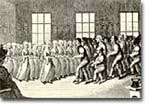
Is there such a thing as a perfect government? One "answer" was the utopian society established by the Shakers. In order to make their society perfect, the Shakers adhered to a strict policy of communal living, religious devotion, (pictured above in their distinctively animated form of worship) celibacy, rigorous labor, and equality.
The last two decades of the 20th century were great for democratic governments. The Cold War ended with the collapse of communist dictatorships throughout Eastern Europe, including the Soviet Union itself. South Korea and Taiwan moved out of their authoritarian pasts toward greater democracy. Apartheid was ended in South Africa.
But democracy is still not the only form of government in the world today. Despite differences in form and function, most of the world's governments still try to fulfill similar primary objectives.
Purposes of Political Systems
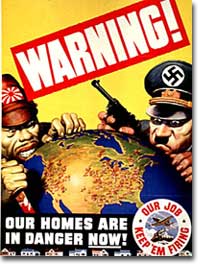
A government can use propaganda to reinforce its image as defender of the nation. This American poster from World War II shows how scare tactics can drum up support (as well as fresh recruits) for the military.
Most governments are designed to provide their inhabitants with two important services: protection from outside invasion and protection of citizens from one another. How many different ways can a government protect from invasions? They can form large armies and navies, build fortified cities, provide border patrols, negotiate with potential enemies, threaten or punish "rogue" states, or join international organizations. The list goes on and on. It makes sense, then, that every country has its own way of accomplishing these basic needs. Of course, some are more successful than others. But some similarities between governments will surely exist as well. For example, more than one country has thought to build strong armies and navies.
Likewise, try to think of different ways that countries can protect citizens from one another. Some commonalties will surely appear — police forces, crime prevention, putting criminals in jail, passing laws that define what is a crime and what is not. Again, governments have different ways to accomplish this end. Some allow more individual freedoms than others, some will have national police forces, and others will organize protection on the local level. As modern governments have taken on more responsibilities, such as regulating the economy and providing social services, the possibilities for different government structures and functions increase.
Purposes of Economic Systems
Economic systems provide needs for citizens by answering several questions:
- What resources does the country have, and what can be produced from them?
- How should goods and services be produced from the available resources?
- How are goods and services distributed among the inhabitants?
Different economic systems around the world answer these questions in different ways.
The resources of an economic system are called factors of production because the economy needs them to produce goods and services. They may be grouped into four categories:
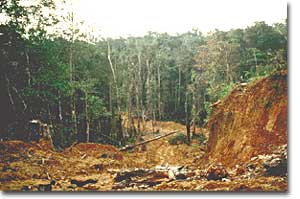
Governments must consider how their citizens use (and replenish) natural resources. Forests, for example, are being depleted at an alarming rate because of human activities like logging. But which is more important: wildlife, or the thousands of families that depend on the income that the logging industry provides?
- Land. This category includes all natural resources, such as soil, water, air, and minerals.
- Labor. Every economy needs human resources — people who produce goods and services.
- Capital. Capital includes money, factories, heavy machinery — anything used to produce products and goods.
- Management. Managers organize and direct the other three factors of production.
The world at the turn of the 21st century was becoming smaller, as global interconnections made distant places seem close. At the same time, bloody nationalist conflicts turning neighbor against neighbor still raged. Government leaders around the world examined their own systems and each others to chart a course for the new millennium.
Show what you know!
Objective 2: Government Involvement
The type of economy a country has is determined by the amount of government involvement in economic decision-making.
What are the basic characteristics of traditional, free market, command, and mixed economies?
Traditional economy
- Economic decisions are based on custom and historical precedent.
- People often perform the same type of work as their parents and grandparents, regardless of ability or potential.
- Traditional economies are most common in places with undeveloped or underdeveloped economies. Traditional economies are typically replaced as countries develop more sophisticated markets (think, for example, of what you learned in World History about the transition of European economies from the Middle Ages through the Industrial Revolution, where traditional cottage industries were replaced with factory jobs)
Free market economy
- A free market economy is characterized by:
- private ownership of property/ resources
- profit motive
- competition
- consumer
- sovereignty
- individual choice
- Adam Smith was one of the founders of free market capitalism.
Command economy
- A command economy is characterized by:
- central ownership of property/resources
- centrally-planned economy
- lack of consumer choice.
- Karl Marx provided the ideological foundation for communist/centrally-planned economies.
Mixed economy
- Individuals and businesses make decisions for the private sector.
- Government makes decisions for the public sector.
- Government's role is greater than in a free market economy and less than in a command economy.
- Most economies today are mixed economies.
Read the following and answer the questions below.
Comparing Economic Systems
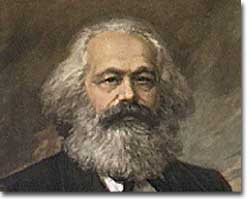
Karl Marx, German philosopher, economist, and revolutionary, laid the ideological groundwork for modern socialism and communism.
Karl Marx and Friedrich Engels turned the world upside down.
Until the publication of their 1848 Communist Manifesto, much of the western world followed a course where individuals owned private property, business enterprises, and the profits that resulted from wise investments. Marx and Engels pointed out the uneven distribution of wealth in the capitalist world and predicted a worldwide popular uprising to distribute wealth evenly. Ever since, nations have wrestled with which direction to turn their economies.
Capitalism
- Capitalism is based on private ownership of the means of production and on individual economic freedom. Most of the means of production, such as factories and businesses, are owned by private individuals and not by the government. Private owners make decisions about what and when to produce and how much products should cost. Other characteristics of capitalism include the following:
- Free competition. The basic rule of capitalism is that people should compete freely without interference from government or any other outside force. Capitalism assumes that the most deserving person will usually win. In theory, prices will be kept as low as possible because consumers will seek the best product for the least amount of money.
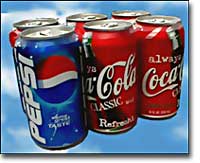
Image from Capitalism Magazine (http://www.CapitalismMagazine.com). Used with permission.
The antitrust lawsuit against Microsoft is one way that the government has tried to promote competition. Supporters of Microsoft say that forcing Microsoft to allow companies to bundle arch-rival Netscape's web browser with Microsoft Windows is not unlike making Coca-Cola include a can of Pepsi in each six-pack it sells.
- Supply and demand. In a capitalist system prices are determined by how many products there are and how many people want them. When supplies increase, prices tend to drop. If prices drop, demand usually increases until supplies run out. Then prices will rise once more, but only as long as demand is high. These laws of supply and demand work in a cycle to control prices and keep them from getting too high or too low.
Communism
Karl Marx, the 19th century father of communism, was outraged by the growing gap between rich and poor. He saw capitalism as an outmoded economic system that exploited workers, which would eventually rise against the rich because the poor were so unfairly treated. Marx thought that the economic system of communism would replace capitalism. Communism is based on principles meant to correct the problems caused by capitalism.
The most important principle of communism is that no private ownership of property should be allowed. Marx believed that private ownership encouraged greed and motivated people to knock out the competition, no matter what the consequences. Property should be shared, and the people should ultimately control the economy. The government should exercise the control in the name of the people, at least in the transition between capitalism and communism. The goals are to eliminate the gap between the rich and poor and bring about economic equality.
Socialism
Socialism, like communism, calls for putting the major means of production in the hands of the people, either directly or through the government. Socialism also believes that wealth and income should be shared more equally among people. Socialists differ from communists in that they do not believe that the workers will overthrow capitalists suddenly and violently. Nor do they believe that all private property should be eliminated. Their main goal is to narrow, not totally eliminate, the gap between the rich and the poor. The government, they say, has a responsibility to redistribute wealth to make society more fair and just.
There is no purely capitalist or communist economy in the world today. The capitalist United States has a Social Security system and a government-owned postal service. Communist China now allows its citizens to keep some of the profits they earn. These categories are models designed to shed greater light on differing economic systems.
Show what you know!
Objective 3: Choice
Maintaining freedom of choice in the marketplace is the basis of the free-enterprise system. Government plays a limited but important role in the protection of individual economic freedoms.
Individuals have the right to the basic economic freedoms enjoyed in a free market society.The government is responsible for protecting these freedoms.
What are some economic freedoms?
Economic freedoms of individuals can include:
- Ability to earn money
- Right to purchase property
- Right to spend incomes on goods and services
- Right to choose occupations or change jobs
- Right to make choices about where and how much to save
- Right to start new businesses and decide what to produce
What is the government's role in protecting these freedoms?
The government has created certain institutions and consumer-protection laws and agencies to protect these freedoms, including the following:
- Consumer Product Safety Commission
- Fair Labor Standards Act
- Occupational Safety and Health Administration (OSHA)
- Food and Drug Administration (FDA)
Comparing Economic Freedom
Not all countries have the same level of economic freedom. In fact, for the last twenty years the Heritage Foundation and the Wall Street Journal have been rating the countries of the world in terms of economic freedom. Let's take a look at this rating.
Read the Introduction and FAQs (especially Q.1, Q.2, and Q.3) on the About the Index page, then take a look at the map. Finally answer the questions below.
Direct Link: https://www.heritage.org/index/about
Direct Link: https://www.heritage.org/index/heatmap
Note: You may find it interesting to use the Create a Comparison Chart feature to compare two countries that catch your interest.
Show what you know!
Objective 4: Economic Freedom and Political Freedom
A strong relationship exists between the economic and political freedoms enjoyed by citizens of free and authoritarian nations.
To what degree are economic freedoms and political freedoms related in democratic and authoritarian nations?
The degree of economic freedom in a nation tends to be directly related to the degree of political freedom its citizens enjoy.
Democratic nations
- High degree of economic freedom
- High degree of political freedom
Authoritarian nations
- Limited economic freedom
- Limited political freedom
Show what you know!
Objective 4: Economic Freedom and Political Freedom (Continued)
Read the following and complete the sorting activity below:
Comparing Governments
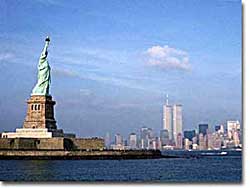
The Statue of Liberty is a symbol of freedom and democracy for people around the world.
No two governments, past or present, are exactly the same.
However, it is possible to examine the similarities and differences among political and economic systems and categorize different forms of government. One simple way to categorize governments is to divide them into democratic and authoritarian political systems.
Democracies
Many countries today claim to be democracies, but if the citizens are not involved in government and politics, they are democratic in name only. Some governments are more democratic than others, but systems cannot be considered truly democratic unless the meet certain criteria:
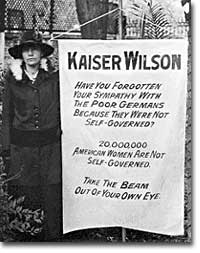
Whither democracy? It was not until 1920 — after decades of tireless protest and campaigning — that women were granted suffrage by the ratification of the 19th Amendment.
- Freedom of speech, the press, and religion. Democracies in general respect these basic individual liberties. No government allows absolute freedom, but democracies do not heavily censor newspapers and public expression of opinions.
- Majority rule with minority rights. In democracies, people usually accept decisions made by the majority of voters in a free election. However, democracies try to avoid the "tyranny of the majority" by providing ways for minorities all kinds to have their voices heard as well.
- Varied personal backgrounds of political leaders. Democracies usually leave room for many different types of citizens to compete for leadership positions. In other words, presidents and legislators do not all come from a few elite families, the same part of the country, or the same social class.
- Free, competitive elections. The presence of elections alone is not enough to call a country a democracy. The elections must be fair and competitive, and the government or political leaders cannot control the results. Voters must have real choices among candidates who run for public office.
- Rule by law. Democracies are not controlled by the whims of a leader, but they are governed by laws that apply to leaders and citizens equally.
- Meaningful political participation by citizens. By itself, a citizen's right to vote is not a good measure of democracy. The government must respond in some way to citizen demands. If they vote, the candidate they choose must actually take office. If they contact government in other ways — writing, protesting, phoning — officials must respond.
The degree to which a government fulfills these criteria is the degree to which it can be considered democratic. Examples of such governments include Great Britain, France, Japan, and the United States.
Authoritarian Regimes
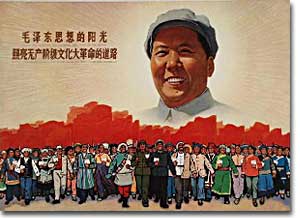
Mao Zedong's position as authoritarian ruler of the People's Republic of China is glorified in this propaganda poster from the Cultural Revolution. The poster reads: "The light of Mao Zedong Thought illuminates the path of the Great Cultural Revolution of the Proletariat."
One ruler or a small group of leaders have the real power in authoritarian political systems. Authoritarian governments may hold elections and they may have contact with their citizens, but citizens do not have any voice in how they are ruled. Their leaders do not give their subjects free choice. Instead, they decide what the people can or cannot have. Citizens, then, are subjects who must obey, and not participants in government decisions. Kings, military leaders, emperors, a small group of aristocrats, dictators, and even presidents or prime ministers may rule authoritarian governments. The leader's title does not automatically indicate a particular type of government.
Authoritarian systems do not allow freedoms of speech, press, and religion, and they do not follow majority rule nor protect minority rights. Their leaders often come from one small group, such as top military officials, or from a small group of aristocratic families. Examples of such regimes include China, Myanmar, Cuba, and Iran.
No nation falls entirely into either category. It also dangerous to categorize a nation simply by the moment in time during which they were examined. The Russia of 1992 was very different from the Russia of 1990. Both democratic and authoritarian governments change over time, rendering the global mosaic uncertain and complex.
Choose whether the following statements apply to a Democracy or an Authoritarian Regime.
Objective 5: Economic Indicators
Formulation of economic policies requires an understanding of accurate measures of the economy's performance.
What are the key economic indicators?
Indicators of economic performance
- Gross Domestic Product (GDP) is the total dollar value of all final goods and services produced in a year.
- Consumer price index (CPI) measures the monthly price changes of sample consumer goods and services.
- Unemployment rate is the percentage of the labor force without jobs.
- Balance of trade is the difference in dollar value between imports and exports.
- Stock market averages are select groups of stocks whose performance is averaged, and over time, the averages serve as an indicator for the market. The Dow Jones Industrial Average, Nasdaq, and the S&P500 are examples of popular stock market averages that are frequently reported in the popular press.
- Productivity is the amount of output per unit of input over a period of time.
Productivity and the standard of living are generally higher in economies that have limited government planning and limited control of the economy.
Match the following economic indicators with the best description:
Objective 5: Economic Indicators (Continued)
Spotlight on GDP
Gross Domestic Product (GDP) is one of the most important indicators of the health of the economy of an entire nation. As you know, the GDP measures the value of all the goods and services that a nation produces. The United States is currently, by far, the world leader in GDP. Take a look at this listing of nations ranked by GDP (be sure to click on "Per Capita" to see a very different perspective of GDP when you think about it "per person").
Just for fun, this map shows each state in the USA and associates it with a country that has a similar GDP (this really just shows how huge the economies of California and Texas are).
NOTE: Due to Business Insider's site settings, you may have to click the Direct Link below to view this map.
Direct Link: https://www.businessinsider.com/map-of-of-us-states-gdp-and-other-countries-2014-2
Objective 6: Entrepreneurship
The entrepreneur sees an economic need and tries to fill it. The Economist defines "entrepreneur" this way:
| Entrepreneur |
| The life and soul of the capitalist party. Somebody who has the idea and enterprise to mix together the other factors of production to produce something valuable. An entrepreneur must be willing to take a risk in pursuit of a profit. |
Source: http://www.economist.com/economics-a-to-z/e#node-21529737
Entrepreneurs are the risk-taking individuals who go out and start their own business. Some of the most famous business people in the world are successful entrepreneurs who started a business and worked to the top. Mark Zuckerberg, Steve Jobs, and Oprah Winfrey are all extremely successful examples of modern entrepreneurs, but millions of entrepreneurs are running smaller, but still successful, business across the country and around the world. Restaurant owners, inventors, hair stylists and artists can all be examples of entrepreneurs.
What is entrepreneurship?

Image Source: http://b-i.forbesimg.com/randalllane/files/2013/11/1112_philanthropy-gates-bono-forbes-cover-120213_768x1008.jpg
Entrepreneurship is the organizational abilities and risk-taking involved in starting a new business or introducing a new product.
Entrepreneurs must be willing to take risks, handle rejection, survive financial uncertainty, and make personal sacrifices.
Profit is an entrepreneur's reward for taking a risk and succeeding.
What is profit?
Profit is the difference between the revenue received from the sale of a good or service and the costs of providing that good or service.
Entrepreneurs must have the freedom to start new business ventures but must accept the responsibilities of that freedom.
What is the relationship between entrepreneurship and economic independence?
Economic structures that provide freedom of choice encourage and have more entrepreneurship.
Show what you know!
Objective 7: Business Structure
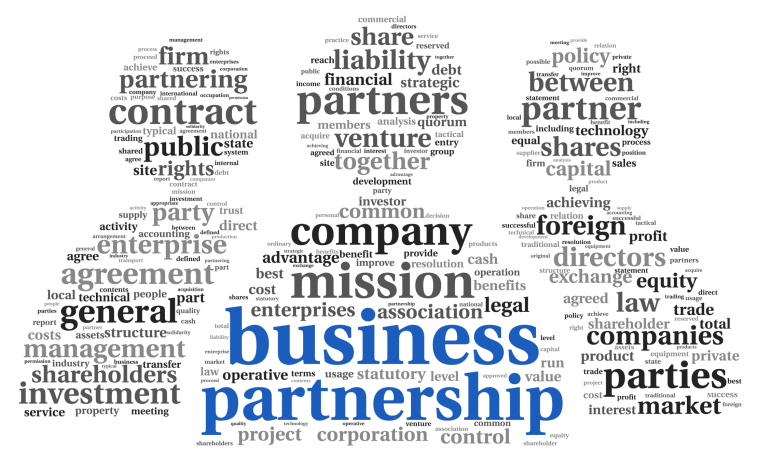
There are three basic ways that businesses organize to earn profits.
What are the basic types of profit-seeking business structures?
Types of profit-seeking business structures
- Proprietorship: A form of business organization with one owner who takes all the risks and all the profits.
- Partnership: A form of business organization with two or more owners who share the risks and the profits.
- Corporation: A form of business organization that is authorized by law to act as a legal entity regardless of the number of owners.
In a corporation, owners share in the profit, and their liability is limited to the amount of their investment.
Match the type of business structure with the correct description:
Objective 8: Factors of Production
The production of goods and services depends on four basic categories of resources, which are interdependent in the production process.
What are the four basic resources (factors of production), and how are they interdependent?
Factors of production
- Labor, also called human resources, is any form of human effort used in the production of goods and services.
- Capital is human-made resources (e.g., tools, buildings, equipment) used in the production of other goods and services.
- Natural resources, also called land resources, are items provided by nature that are used in the production of goods and services.
- An entrepreneur is the risk-taker who organizes the other resources for production.
All production depends on natural resources, which need capital for conversion to usable goods and labor to make the conversion.
Show what you know!
Objective 9: Supply and Demand
The interaction of supply and demand in a market economy determines price.
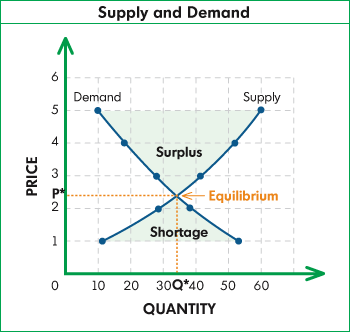
Source: https://resourcesforhistoryteachers.wikispaces.com/file/view/supply_and_demand.gif/327401004/supply_and_demand.gif
| | Definition | Laws | Determinants | Equilibrium |
Demand | Willingness and ability to buy various quantities of a good or service at various prices | Law of Demand: Quantity demanded varies inversely to price. If all else remains equal, the lower the price, the higher the quantity demanded, and the higher the price, the lower the quantity demanded. | Factors other than price influencing demand: substitutes, complements, number of demanders, consumer preference, income | Equilibrium is the point where supply and demand balance each other; below this point is a shortage, and above this point is a surplus. |
Supply | Willingness and ability to provide various quantities of a good or service at various prices | Law of Supply: Quantity supplied varies directly with price. If all else remains equal, the lower the price, the lower the quantity supplied, and the higher the price, the higher the quantity supplied. | Factors other than price influencing supply: number of producers, technology, government policies, productivity of resources | Equilibrium is the point where supply and demand balance each other; below this point is a shortage, and above this point is a surplus. |
Let's take another look at the following video (you viewed this earlier in the section Overview). It is short but provides a lot of information in that short time. Before you watched it to just get the gist, so you will want to watch it for understanding this time.
Show what you know!
Objective 10: Circular Flow
Households, businesses, and government are interdependent in a market economy. Resources, goods and services, and money constantly flow in a market economy.
How do households, businesses, and government interact to sustain the operation of a market economy?
The interaction of households, businesses, and government are referred to as the "circular flow" of economic activity.
- Households, which are owners of the factors of production, sell those resources to businesses .
- Businesses use the resources to produce goods and services that households want.
- Households use the money from the sale of resources to purchase goods and services.
- Businesses use the money from the sale of goods and services to buy more productive resources.
- Government taxation policies and regulations may speed up or slow down the flow of resources, goods and services, and money in a market economy.
Below is the graphic from the end of the video.
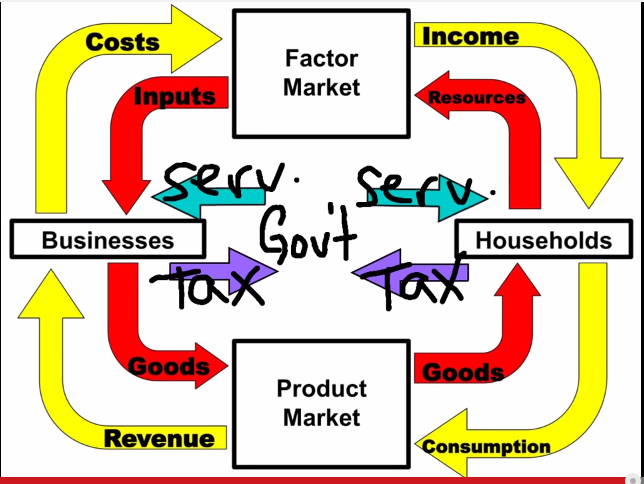
Show what you know!
Objective 11: Global Economy
The economies of individual nations are interdependent.
How have enhanced information flows created an expansion of markets for businesses and consumers worldwide?
United States businesses have become multinational in their quest for productive resources, markets, and profits. United States firms may move factories to other countries to reduce costs (off-shoring).
The economy of the United States depends on resources and markets around the world for the production and sale of goods and services.
How does technology facilitate working across borders?
Advances in technology allow businesses to get skilled work, such as engineering and accounting, done by people who remain in their home countries (i.e., to outsource this work). This increases the supply of workers and holds wages and costs of production down.
How does immigration affect the supply of labor in the United States?
Immigration brings workers into the country and increases the supply of labor.
How does changing worldwide supply of and demand for limited natural resources affect their prices?
As foreign countries develop and grow, they demand more products and natural resources, such as oil, pushing up prices. Total world production is greater when nations specialize in the production of those products that they can produce most efficiently.
What is a trade deficit?
When the United States imports more goods and services than it exports, the difference is the trade deficit.
Who are the major trading partners for Virginia and the United States?
Canada, Mexico, the European Union, China, and Japan are the major trading partners of the United States.
Show what you know!
End of Module
This ends the Unit 4 Section 1—Economics Reading Module. If you have finished answering questions, be sure to click Finish. If you need to return to complete questions, exit this window, and your results will be saved for your next session.











